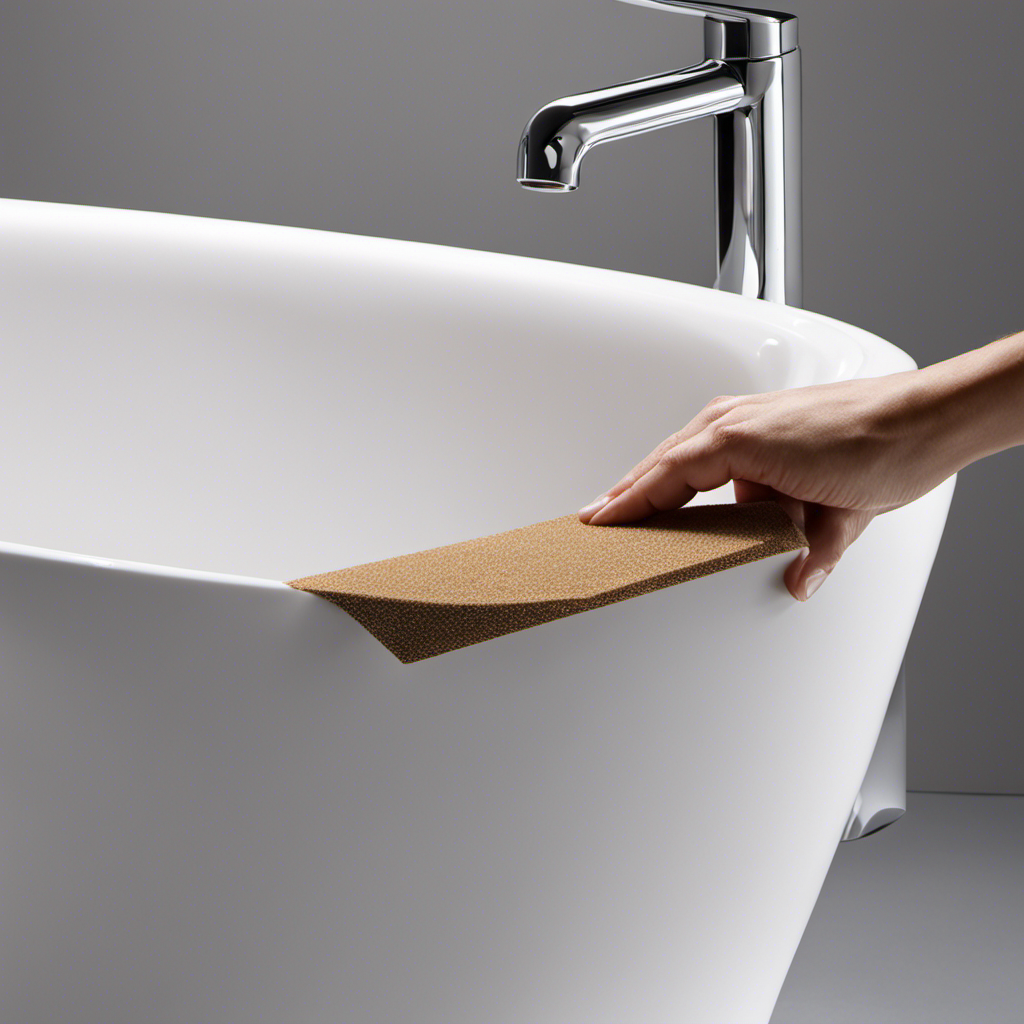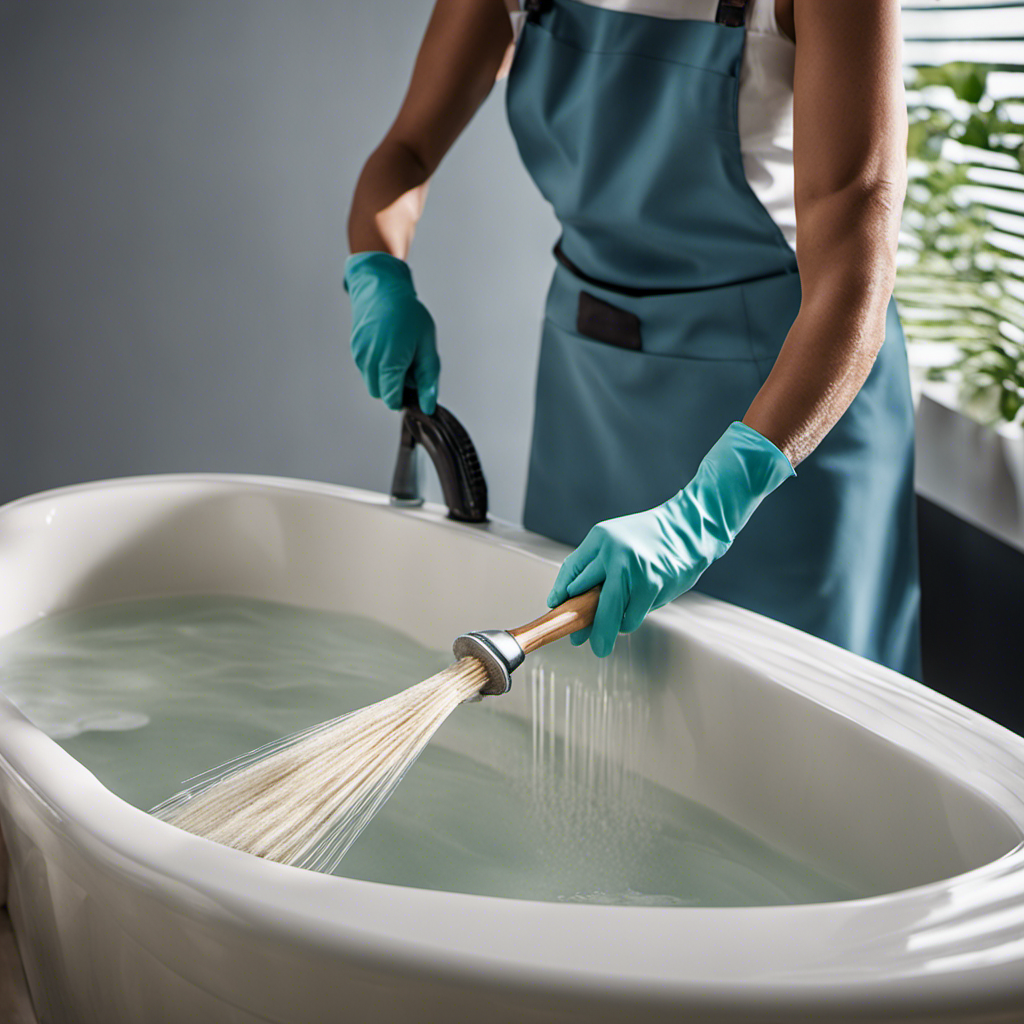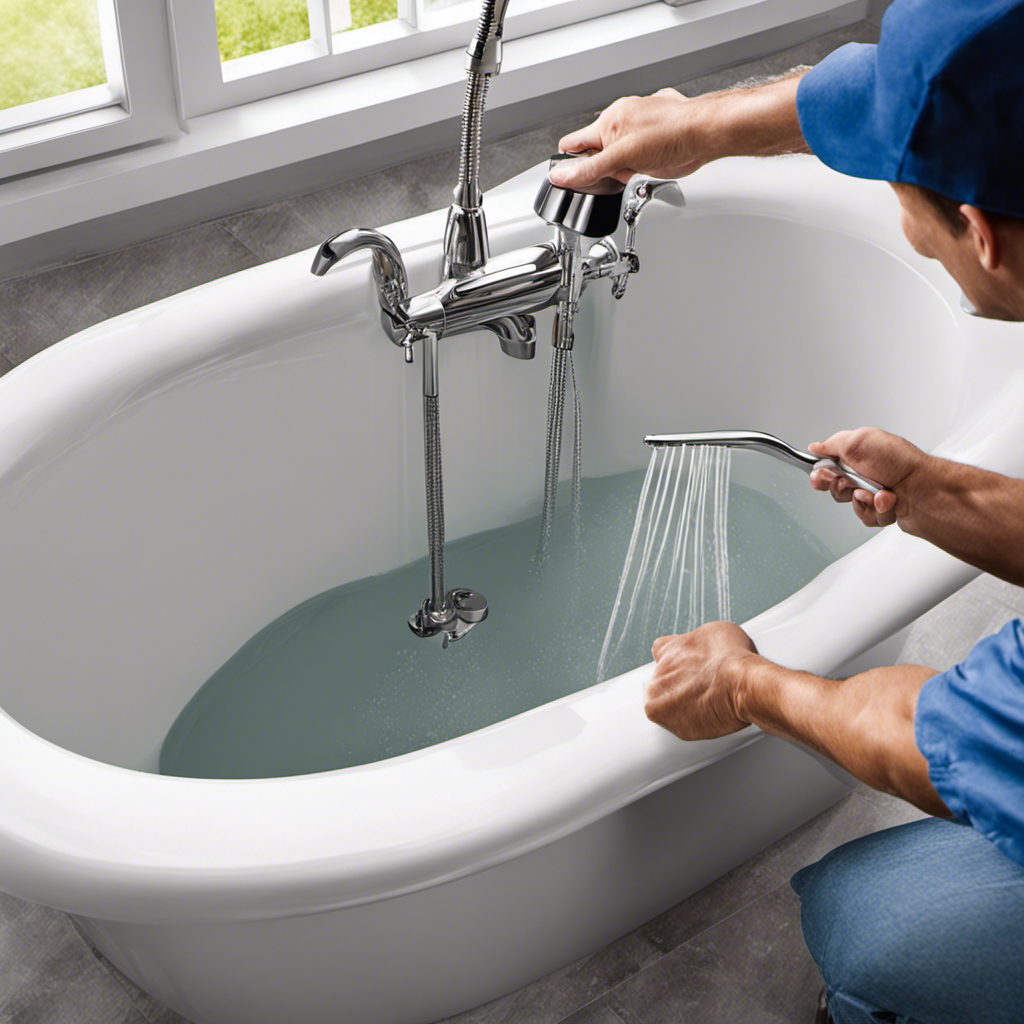As someone who has encountered the frustration of a wobbly bathtub, I understand the importance of achieving a level surface.
Luckily, leveling a bathtub is a straightforward process that can be done with a few simple steps.
In this article, I will guide you through the process of:
- Assessing the current level
- Preparing the floor
- Adjusting the bathtub legs or supports
- Using shims to ensure stability
By the end, you’ll have a perfectly level bathtub that will bring peace and relaxation to your bathing experience.
Key Takeaways
- Assess the current level of the bathtub, looking for uneven surfaces, gaps between the tub and walls, water pooling, cracked tiles or grout, and difficulty in draining.
- Prepare the floor for leveling by removing existing flooring material, inspecting the subfloor for damage or rot, repairing or replacing compromised areas, and cleaning the subfloor thoroughly.
- Adjust the bathtub legs or supports by inspecting them for proper attachment, tightening loose connections, adjusting leg height for leveling, using shims to fill gaps, and testing the stability of the bathtub.
- Use tools such as shims, leveling pads, adjustable feet, screws and nuts, and floor leveling compound for leveling the bathtub if necessary.
Tools and Materials Needed
You’ll need a few tools and materials to level the bathtub correctly. Creating a level base is essential for ensuring that the bathtub is properly supported and stable.
To achieve this, you will need a level, measuring tape, shims, a screwdriver, and a construction adhesive. The level will help you determine if the base is even, while the measuring tape will ensure accurate measurements.
Shims are necessary for adjusting the height of the bathtub to create a level surface. A screwdriver is needed to secure the shims in place. Lastly, the construction adhesive is used to bond the shims to the subfloor, providing proper support for the bathtub.
It is important to use these tools and materials to create a level base as it ensures the longevity and functionality of the bathtub.
Assessing the Current Level of the Bathtub
Assessing if the tub’s alignment needs adjustment can be done by checking for any unevenness or wobbling. To troubleshoot bathtub stability, here are some key indicators to look out for:
- Uneven surface: If the tub rocks back and forth or feels unstable when pressure is applied.
- Gaps between tub and walls: Check for any gaps or spaces between the tub and the surrounding walls.
- Water pooling: Examine if water accumulates in certain areas of the tub, indicating a lack of proper leveling.
- Cracked tiles or grout: These can be signs of a misaligned bathtub, causing stress on the surrounding materials.
- Difficulty in draining: If the water drains slowly or doesn’t drain at all, it could be due to an uneven bathtub.
By assessing these factors, you can determine if your bathtub requires leveling techniques.
Now, let’s move on to preparing the floor for leveling.
Preparing the Floor for Leveling
Once you’ve checked for any unevenness or wobbling, it’s time to prepare the floor for leveling. Floor preparation is crucial to ensure a stable and even surface for your bathtub.
To begin, remove any existing flooring material, such as tiles or linoleum, to expose the subfloor. Inspect the subfloor for any damage or rot. Repair or replace any compromised areas to guarantee a solid foundation.
Next, clean the subfloor thoroughly, removing any dirt, debris, or adhesive residue. This will provide a clean surface for the leveling materials to adhere to.
Adjusting the Bathtub Legs or Supports
When it comes to ensuring the stability of bathtub legs, there are a few key points to consider.
First, adjusting the support height is crucial in order to achieve a level and secure installation. This can be done easily without the need for any special tools, making the process convenient and efficient.
Stability of Bathtub Legs
To ensure stability, you’ll need to check if the bathtub legs are securely attached. Here are some steps to help you with this process:
-
Inspect the legs: Check if all the legs are properly attached to the bathtub. Look for any loose screws or bolts.
-
Tighten the connections: If you find any loose connections, use a wrench or screwdriver to tighten them. This will help prevent future instability.
-
Adjust leg height: If the bathtub is not level, you may need to adjust the height of the legs. Use a level to determine which leg needs adjustment and then use an adjustable wrench to make the necessary changes.
-
Use shims: If the legs are not long enough to level the bathtub, you can use shims to fill the gap. Place the shims under the legs and adjust until the bathtub is level.
-
Test for stability: Once you have made the necessary adjustments, test the stability of the bathtub by applying pressure to different areas. If it feels solid and doesn’t wobble, then you have successfully ensured stability.
Adjusting Support Height
Adjusting the height of the support legs is crucial for ensuring stability in the bathtub. Properly raising the support legs ensures that the bathtub is level and prevents any rocking or instability.
There are several alternative methods for raising the support legs to achieve the desired level. One method is using adjustable support legs that can be extended or retracted to the desired height. Another method is using shims, which are thin pieces of material that can be placed under the support legs to raise them to the desired level. Additionally, leveling pads can also be used to adjust the height of the support legs. These pads are placed under the legs and can be easily adjusted to achieve the desired level.
These alternative methods provide flexibility and convenience in adjusting the support height of the bathtub.
In the next section, we will explore how to level a bathtub without the need for tools.
Leveling Without Tools
One way to achieve a level surface in the bathtub is by using shims or leveling pads. These DIY leveling methods can help ensure that your bathtub is stable and comfortable to use. Here are five techniques you can try:
-
Shims: Place shims under the bathtub’s legs or base to level it. Adjust the thickness of the shims until the bathtub is stable.
-
Leveling Pads: Use leveling pads made of rubber or foam to create a stable and level surface. These pads can be easily adjusted to achieve the desired height.
-
Adjustable Feet: Some bathtubs come with adjustable feet that can be used to level the bathtub. Simply adjust the height of the feet until the bathtub is level.
-
Screws and Nuts: Install screws and nuts at the bottom of the bathtub’s legs. By adjusting the height of the screws, you can level the bathtub.
-
Floor Leveling Compound: If the floor beneath the bathtub is uneven, you can use a floor leveling compound to create a level surface. Follow the manufacturer’s instructions for proper application.
Using Shims to Level the Bathtub
You can use shims to level the bathtub and ensure it is stable and secure. Shims are thin pieces of material that can be placed under the tub to adjust its height and correct any unevenness. While shims are commonly used for bathtub leveling, there are also alternative techniques available. Here is a comparison of shim alternatives and bathtub leveling techniques:
| Shim Alternatives | Bathtub Leveling Techniques |
|---|---|
| Wedges | Self-leveling compound |
| Rubber mats | Adjustable feet |
| Foam | Sand leveling |
| Plastic spacers | Jacking up the bathtub |
| Wood blocks | Support brackets |
Each alternative has its own advantages and disadvantages, so it’s important to choose the method that best suits your needs. Remember to follow the manufacturer’s instructions and take necessary safety precautions when leveling your bathtub.
Testing the Stability and Resealing the Bathtub
To test the stability of your bathtub and ensure it is secure, start by checking for any movement or wobbling when pressure is applied.
Here are some steps to retest the bathtub stability and reseal the bathtub joints:
- Apply pressure to different areas of the bathtub, such as the sides and corners, to check for any movement or shifting.
- Inspect the bathtub legs or base for any signs of wear or damage.
- Check the bathtub’s caulking and grout for any cracks or gaps that may indicate a need for resealing.
- Use a level to ensure the bathtub is still properly aligned and not tilted.
- If necessary, reseal the bathtub joints using a silicone caulk to prevent water leakage and maintain stability.
Conclusion
After following these steps and using the necessary tools and materials, you should now have a level bathtub that is stable and secure.
Remember the old saying, ‘A level bathtub is a happy bathtub!’
By taking the time to properly level your bathtub, you can ensure that it will provide you with years of comfort and relaxation.
So go ahead, take a soak and enjoy the peace of mind that comes with knowing your bathtub is level and secure.










